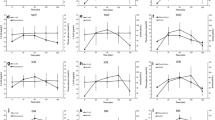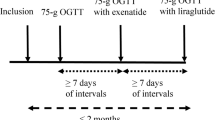Summary
Increased endogenous glucose production (EGP) and gluconeogenesis contribute to the pathogenesis of hyperglycaemia in non-insulin-dependent diabetes mellitus (NIDDM). In healthy subjects, however, EGP remains constant during administration of gluconeogenic precursors. This study was performed in order to determine whether administration of fructose increases EGP in obese NIDDM patients and obese non-diabetic subjects. Eight young healthy lean subjects, eight middle-aged obese NIDDM patients and seven middle-aged obese non-diabetic subjects were studied during hourly ingestion of 13C fructose (0.3 g · kg fat free mass−1 · h−1) for 3 h. Fructose failed to increase EGP (measured with 6,6 2H glucose) in NIDDM (17.7±1.9 Μmol · kg fat free mass−1 · min−1 basal vs 15.9±0.9 after fructose), in obese non-diabetic subjects (12.1±0.5 basal vs 13.1±0.5 after fructose) and in lean healthy subjects (13.3±0.5 basal vs 13.8±0.6 after fructose) although 13C glucose synthesis contributed 73.2% of EGP in lean subjects, 62.6% in obese non-diabetic subjects, and 52.8% in obese NIDDM patients. Since glucagon may play an important role in the development of hyperglycaemia in NIDDM, healthy subjects were also studied during 13C fructose ingestion + hyperglucagonaemia (232±9 ng/l) and during hyperglucagonaemia alone. EGP increased by 19.8% with ingestion of fructose + glucagon (p<0.05) but remained unchanged during administration of fructose or glucagon alone. The plasma 13C glucose enrichment was identical after fructose ingestion both with and without glucagon, indicating that the contribution of fructose gluconeogenesis to the glucose 6-phosphate pool was identical in these two conditions. We concluded that during fructose administration: 1) gluconeogenesis is increased, but EGP remains constant in NIDDM, obese non-diabetic, and lean individuals; 2) in lean individuals, both an increased glucagonaemia and an enhanced supply of gluconeogenic precursors are required to increase EGP; this increase in EGP occurs without changes in the relative proportion of glucose 6-phosphate production from fructose and from other sources (i. e. glycogenolysis + gluconeogenesis from non-fructose precursors).
Similar content being viewed by others
Abbreviations
- EGP:
-
Endogenous glucose production
- CHO:
-
carbohydrate
- APE:
-
atom percent excess
- GRd:
-
glucose rate of disappearance
- FFM:
-
fat-free mass
References
Winkler B, Rathgeb I, Steele R, Altszuler N (1970) Conversion of glycerol to glucose in the normal dog. Am J Physiol 219: 497–502
Jenssen T, Nurjhan N, Consoli A, Gerich JE (1990) Failure of substrate-induced gluconeogenesis to increase overall glucose appearance in normal humans. J Clin Invest 86: 489–497
Jahoor F, Peters EJ, Wolfe RR (1990) The relationship between gluconeogenic substrate supply and glucose production in humans. Am J Physiol 258: E288-E296
Wolfe RR, Jahoor F, Shaw JHF (1987) Effect of alanine infusion on glucose and urea production in man. J Parenter Enter Nutr 11: 109–111
Tounian P, Schneiter Ph, Henry S, Jéquier E, Tappy L (1994) Effects of infused fructose on endogenous glucose production, gluconeogenesis and glycogen metabolism in healthy humans. Am J Physiol 267: E710-E717
DeFronzo RA, Ferrannini E, Simonson DC (1989) Fasting hyperglycaemia in non-insulin dependent diabetes mellitus: contributions of excessive hepatic glucose production and impaired tissue glucose uptake. Metabolism 38: 387–395
Felig P, Wahren J, Hendler R (1978) Influence of maturity-onset diabetes on splanchnic glucose balance after oral glucose ingestion. Diabetes 27: 121–126
Magnusson I, Rothman DL, Katz LD, Shulman RG, Shulman GI (1992) Increased rate of gluconeogenesis in type II diabetes mellitus. A 13C nuclear magnetic resonance study. J Clin Invest 90: 1323–1327
Tappy L, Acheson K, Curchod B et al. (1994) Overnight glucose metabolism in obese non-insulin-dependent diabetic patients and in healthy lean individuals. Clin Physiol 14: 251–265
Nurjhan N, Consoli A, Gerich J (1992) Increased lipolysis and its consequence on gluconeogenesis in non-insulin dependent diabetes mellitus. J Clin Invest 89: 169–175
Consoli A, Nurjhan N, Reilly JJJ et al. (1990) Mechanism of increased gluconeogenesis in non insulin-dependent diabetes mellitus. J Clin Invest 86: 2038–2045
Lefèbvre P, Paolisso G, Scheen A (1991) The role of glucagon in non-insulin-dependent (type 2) diabetes mellitus. In: Sakamoto N, Angel A, Hotta N (eds) New directions in research and clinical works for obesity and diabetes mellitus. Elsevier Science Publishers B. V., Amsterdam, pp 25–29
Tappy L, Acheson K, Normand S et al. (1992) Effects of infused amino acids on glucose oxidation, endogenous glucose production and 13C glucose synthesis from 13C bicarbonate in healthy human subjects. Am J Physiol 262: E826-E833
Boden G, Tappy L, Jadali F, Hoeldtke RD, Rezvani I, Owen OE (1990) Role of glucagon in disposal of an amino acid load. Am J Physiol 259: E225-E232
Durnin JVGA, Womersley J (1974) Body fast assessment for total body density and its estimation from skinfold thickness: measurements on 481 men and women aged from 16 to 72 years. Br J Nutr 32: 77–97
Jéquier E, Felber J (1987) Indirect calorimetry. Baillieres Clin Endocrinol Metab 1: 911–935
DeBodo R, Steele R, Altzuler N, Dunn A, Bishop J (1963) On the hormonal regulation of carbohydrate metabolism: studies with 14C-glucose. Recent Prog Horm Res 19: 445–488
Chiasson JL, Liljenquist JE, Lacy WW, Jennings AS, Cherrington AD (1977) Gluconeogenesis: methodological approach in vivo. Fed Proc 36: 229–235
Tappy L, Owen O, Boden G (1988) Effect of hyperinsulinemia on urea pool size and substrate oxidation rates. Diabetes 37: 1212–1217
Livesey G, Elia M (1988) Estimation of energy expenditure, net carbohydrate utilization, and net fat oxidation and synthesis by indirect calorimetry evaluation of errors with special reference to the detailed composition of foods. Am J Clin Nutr 47: 608–628
Robert JJ, Koziet J, Chauvet D, Darmaun D, Desjeux JF, Young VR (1987) Use of 13C-labeled glucose for estimating glucose oxidation: some design considerations. J Appl Physiol 63: 1725–1732
Gay LJ, Schneiter P, Schutz Y, Di Vetta V, Jéquier E, Tappy L (1994) A non-invasive assessment of hepatic glycogen kinetics and post-absorptive gluconeogenesis in man. Diabetologia 37: 517–523
Schmidt FH (1961) Die enzymatische Bestimmung von Glucose und Fructose nebeneinander. Klin Wochenschr 39: 1244–1247
Hawk P (1947) Practical physiological chemistry. 12th edn. Blakiston, Toronto, pp 814–822
Menahan A, Wieland O (1969) The role of endogenous lipid in gluconeogenesis and ketogenesis in perfused rat liver. Eur J Biochem 9: 182–188
Williamson JR, Kreisberg RA, Felts PW (1966) Mechanism for the stimulation of gluconeogenesis by fatty acids in perfused rat liver. Biochemistry 56: 247–254
Fanelli C, Calderone S, Epifano L et al. (1993) Demonstration of critical role for free fatty acids in mediating counter-regulatory stimulation of gluconeogenesis and suppression of glucose utilization in humans. J Clin Invest 29: 1617–1622
Clore JN, Glickman PS, Nestler JE, Blackard WG (1991) In vivo evidence for hepatic autoregulation during FFA-stimulated gluconeogenesis in normal humans. Am J Physiol 261: E425-E429
Schwarz JM, Neese R, Shackleton C, Hellerstein MK (1993) De novo lipogenesis during fasting and oral fructose in lean and obese hyperinsulinemic subjects. Diabetes 42 [Suppl] 1: 39A (Abstract)
Puhakainen I, Koivisto VA, Yki-Jarvinen H (1991) No reduction in total hepatic glucose output by inhibiton of gluconeogenesis with ethanol in NIDDM patients. Diabetes 40: 1319–1327
Ferrannini E, DeFronzo RA, Sherwin RS (1982) Transient hepatic response to glucagon in man: role of insulin and hyperglycaemia. Am J Physiol 242: E73-E81
Flatt JP (1978) The biochemistry of energy expenditure. In: Bray GA (ed) Recent advances in obesity research. Newman Publishing, London, pp 211–228
McGuinness OP, Murrell S, Moran C, Bracy D, Cherrington AD (1994) The effect of acute glucagon removal on the metabolic response to stress hormone infusion in the conscious dog. Metabolism 43: 1310–1317
Hendrick GK, Wasserman DH, Frizzell RT et al. (1992) The importance of basal glucagon in maintaining hepatic glucose production during a prolonged fast in the conscious dog. Am J Physiol 263: E541-E549
Author information
Authors and Affiliations
Rights and permissions
About this article
Cite this article
Paquot, N., Schneiter, P., Jéquier, E. et al. Effects of ingested fructose and infused glucagon on endogenous glucose production in obese NIDDM patients, obese non-diabetic subjects, and healthy subjects. Diabetologia 39, 580–586 (1996). https://doi.org/10.1007/BF00403305
Received:
Revised:
Issue Date:
DOI: https://doi.org/10.1007/BF00403305




